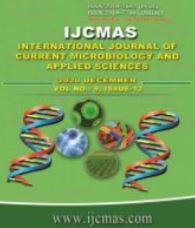


 National Academy of Agricultural Sciences (NAAS)
National Academy of Agricultural Sciences (NAAS)

|
PRINT ISSN : 2319-7692
Online ISSN : 2319-7706 Issues : 12 per year Publisher : Excellent Publishers Email : editorijcmas@gmail.com / submit@ijcmas.com Editor-in-chief: Dr.M.Prakash Index Copernicus ICV 2018: 95.39 NAAS RATING 2020: 5.38 |
Brinjal (Solanum melongena L.) is an important vegetable crop occupies more areas in India. In Tamil Nadu it is cultivated in Dindigul, Coimbatore, Madurai, Ramanathapuram, Virudhunagar, Vellore, Salem, Tirunelveli and Krishnagiri districts in larger areas. Vegetable crops were cultivated in 2000 ha area and it is being cultivated in Kamuthi, Paramakudi, Bogalur and Nainarkoil blocks of Ramanathapuram district. Farmers were cultivated local varieties, adopted local technologies, getting low income, low yield and unaware new technologies for cultivation of brinjal. With this background, Front Line Demonstration (FLD) on “Integrated Crop Management (ICM) practices in brinjal” was carried out by Krishi Vigyan Kendra, Ramanathapuram at farmers’ field during the year 2017-18 with the aim to study the extent of adoption of integrated crop management in brinjal, to study the yield and economics of brinjal production and doubling the farmers’ income. Demonstration was carried out at Bogalur, Mandapam and Nainarkoil blocks of Ramanathapuram district with two ha area and conducted ten demonstrations. Inputs like arka vegetable special, neem soap, Pseudomonas fluoresences, Wota – T traps and yellow sticky traps were purchased and distributed to the ten identified farmers. Front Line Demonstration results revealed that demonstration plots recorded the highest values in growth characters viz., plant height (42.15 cm), number of fruits per plant (51.0) and average fruit weight (62.5 g) while farmer practices registered the lowest values in all the vegetative traits. Regarding yield characters, demonstrated practices recorded the highest yield per ha (19.12 t/ha), yield per plant (3.13 kg), net returns (Rs. 1,18,700) with the cost benefit ratio of 3.22. Whereas farmer practices (local practices) registered the lowest yield (15.32 t/ha), yield per plant (2.25 kg), net returns (Rs. 80,100) and cost benefit ratio of 2.38. Regarding shoot and fruit borer and aphids incidences, demonstrated plot recorded very low incidence (5.23 %; 4.05 %) whereas farmers practices noticed higher incidence (19.50%; 11.66 %) of both the insects. Adoption of new technology increased the yield of 24 per cent over the farmer practices.
 |
 |
 |
 |
 |